Which?
Which of Anita North’s five images do you think is the strongest? Why? Also, you may wish to learn something by trying to answer the Aperture Errors Question below.
What’s Up?
Early on Saturday morning, I sat on a plastic milk crate in the marsh behind my tripod-mounted 600 GM/a1. Anita was to my left with the same gear, sitting on a small plastic stool. Two minutes after we were in place two Black-necked Stilts flew in and landed right in front of us. That was just the beginning of a truly great morning.
I did lots of catching up on e-mails and doing critiques in the Avian Forum at BPN. Since 12-13-2007, I have commented on or created 31,339 threads. I was pleased to learn that Dan Womack sold his Canon EF 100-400 f/4.5-5.6L IS II lens in mint condition for $1449.00 within hours of it being listed in yesterday’s blog post.
Today is Sunday 16 May 2021 and the forecast is perfect for sitting in the marsh: mostly sunny with a soft northeast breeze!. So that is exactly what we will be doing at 6:45am. Wherever you are, and whatever you are doing, I hope that you have a great day.
This blog post took about two hours to prepare and makes 143 consecutive days with a new one. Please remember that if an item — a Delkin flash card, or a tripod head — for example, that is available from B&H and/or Bedfords and is also available in the BAA Online Store, it would be great if you opt to purchase from us. We will match any price. Please remember also to use my B&H affiliate links or to save 3% at Bedfords by using the BIRDSASART discount code at checkout. Doing either often earns you free guides and/or discounts. And doing so always earns my great appreciation.
Please Remember
With income from IPTs now at zero, please, if you enjoy and learn from the blog, remember to use one of my two affiliate programs when purchasing new gear. Doing so just might make it possible for me to avoid having to try to get a job as a Walmart greeter and will not cost you a single penny more. And if you use Bedfords and remember to enter the BIRDSASART code at checkout, you will save 3% on every order and enjoy free second-day air shipping. In these crazy times — I am out at least forty to sixty thousand dollars so far due to COVID 19 (with lots more to come) — remembering to use my B&H link or to shop at Bedfords will help me out a ton and be greatly appreciated. Overseas folks who cannot order from the US because of import fees, duties, and taxes, are invited to help out by clicking here to leave a blog thank you gift if they see fit.
New and Better Bedfords Discount Policy!
You can now save 3% on all of your Bedfords photo gear purchases by entering the BIRDSASART coupon code at checkout. Your discount will be applied to your pre-tax total. In addition, by using the code you will get 2nd day air shipping via Fed Ex.
Grab a Nikon AF-S Teleconverter TC-14E III and save $14.99. Purchase a Canon EOS R5 and your discount will be $116.97. Purchase a Sony FE 600mm f/4 GM OSS lens and save a remarkable $389.94! Your Bedford’s purchase no longer needs to be greater than $1,000.00 for you to receive a discount. The more you spend, the more you save.
Money Saving Reminder
Many have learned that if you need a hot photo item that is out of stock at B&H and would enjoy free second-day air shipping, your best bet is to click here, place an order with Bedfords, and enter the coupon code BIRDSASART at checkout. If an item is out of stock, contact Steve Elkins via e-mail or on his cell phone at (479) 381-2592 (Central time). Be sure to mention the BIRDSASART coupon code and use it for your online order to save 3% and enjoy free 2nd-day air shipping. Steve has been great at getting folks the hot items that are out of stock at B&H and everywhere else. The wait lists at the big stores can be a year or longer for the hard to get items. Steve will surely get you your gear long before that. For the past year, he has been helping BAA Blog folks get their hands on items like the SONY a9 ii, the SONY 200-600 G OSS lens, the Canon EOS R5, the Canon RF 100-500mm lens, and the Nikon 500mm PF. Steve is personable, helpful, and eager to please.


Gear Questions and Advice
Too many folks attending BAA IPTs (remember those?) and dozens of photographers whom I see in the field and on BPN, are–out of ignorance–using the wrong gear especially when it comes to tripods and more especially, tripod heads… Please know that I am always glad to answer your gear questions via e-mail
|
|
|
This image was created on 14 May 2021 down by the lake at ILE. Working from my SUV with the lens resting on a lowered window, I used Sony FE 600mm f/4 GM OSS lens and The One, the Sony Alpha 1 Mirrorless digital camera. ISO 800. Exposure determined via Zebras with ISO on the rear dial: 1/500 sec. at f/4 (wide open) in Manual mode. AWB at 7:30am on a cloudy morning. Zone/AF-C was active at the moment of exposure and performed perfectly. Click on the image to see a larger version. Image #1: Anita North in marsh |
I Thought She Was Nuts!
When I first saw Anita sitting in the marsh, I thought that she was nuts. She had been observing the stilts on and off for about a week and had faith that they would land in front of her. That despite that fact that I had recently sat at the edge of a small mudflat at DeSoto and had firmly believed that if you sat, they would come.
|
|
|
This image was created on 14 May 2021 by Anita North in the marsh along the lakeshore at ILE. She used the Zone/AF-C was active at the moment of exposure and performed perfectly by nailing the plover’s eye. Click on the image to see a larger version. Image #2: Black-necked Stilts copulating |
Copulations
The first pair that landed in front of Anita did the whole courtship deal: the female crouched in invitation while the male strutted around her splashing water with his bill. Then he mounted, her and they copulated. When he hopped off her, he put one raised wing over his mate, and they intertwined their necks in a seemingly loving embrace. Not a bad way to start!
|
|
|
This image was also created on 14 May 2021 by Anita North in the marsh along the lakeshore at ILE. She used the Induro GIT 304L/Mongoose M3.6-mounted Sony FE 600mm f/4 GM OSS lens and The One, the Sony Alpha 1 Mirrorless digital camera. ISO 3200. Exposure determined via Zebras with ISO on the rear dial: 1/500 sec. at f/4 (wide open) in Manual mode. AWB at 7:03am on a cloudy morning. Zone/AF-C was active at the moment of exposure and performed perfectly by nailing the plover’s eye. Click on the image to see a larger version. Image #3: Black-necked Stilts starting to squabble |
The Squabbles
As many as six stilts are often involved in fairly violent, exceedingly-difficult-to-photograph squabbles. In a way, Anita was lucky on her first attempt to have a cloudy morning. As there was no sun, she was able to photograph birds in positions where they would have been terribly sidelit on a clear morning.
|
|
|
This image was also created on 14 May 2021 by Anita North in the marsh along the lakeshore at ILE. She used the Induro GIT 304L/Mongoose M3.6-mounted Sony FE 600mm f/4 GM OSS lens and The One, the Sony Alpha 1 Mirrorless digital camera. ISO 2500. Exposure determined via Zebras with ISO on the rear dial: 1/1000 sec. at f/4 (wide open) in Manual mode. AWB at 7:07am on a cloudy morning. Zone/AF-C was active at the moment of exposure and performed perfectly. Click on the image to see a larger version. Image #4: Black-necked Stilt in flight |
Flight Opportunities
On occasion, there are decent flight chances with the BNSTs as they fly to and from their three favorite spots well to the left of the pier. In addition, there is no telling what will fly by: Great and Snowy Egrets, Green, Little Blue, and Tricolored Herons, Fish Crow, Red-winged Blackbird, Boat-tailed Grackle, Black-bellied Whistling Duck, Mottled Duck, Osprey, and Bald Eagle are all likely.
|
|
|
This image was created on 15 May 2021 by Anita North in the marsh along the lakeshore at ILE. She used the Induro GIT 304L/Mongoose M3.6-mounted Sony FE 600mm f/4 GM OSS lens and The One, the Sony Alpha 1 Mirrorless digital camera. ISO 2500. Exposure determined via Zebras with ISO on the rear dial: 1/1000 sec. at f/5.6 (stopped down 1 stop in error) in Manual mode. AWB at 6:54am on just before sunrise. Tracking: Zone/AF-C was active at the moment of exposure and performed perfectly by nailing the plover’s eye. Click on the image to see a larger version. Image #5: Black-necked Stilt flapping after bath |
Aprés Bath
On a recent IPT, I called out that a Willet would jump into the air and flap. I even predicted that the bird would turn to its right before jumping up. That, after repeatedly dipping its breast in the water and splashing around. Several folks were stunned. How did you know that that would happen? More than nine times out of ten, when you see a bird, any bird, dipping its breast in the water to bathe, it will flap in place and then jump up and flap some more as it heads back to the shoreline. And since the wind was from behind us, I knew that it would turn so that it could flap (and fly) into the wind. Knowledge of bird behavior can get you images that you might otherwise miss.
|
|
|
This image was also created on 15 May 2021 by Anita North in the marsh along the lakeshore at ILE. She used the Induro GIT 304L/Mongoose M3.6-mounted Sony FE 600mm f/4 GM OSS lens and The One, the Sony Alpha 1 Mirrorless digital camera. ISO 2500. Exposure determined via Zebras with ISO on the rear dial: 1/1000 sec. at f/5.6 (stopped down 1 stop in error) in Manual mode. AWB at 6:53am just before sunrise. Tracking: Zone/AF-C was active at the moment of exposure and performed perfectly by nailing the plover’s eye. Click on the image to see a larger version. Image #6: Black-necked Stilts battling |
The Holy Grail Shot!
It seem that the stilts from adjoining territories will meet up to fight just once each morning. On day two in the marsh, the big battle took place right in front of us. I pretty much fanned on all of my attempts as I struggled to properly frame the combatants as they jumped into the air. Anita did a great job with this one.
Aperture Errors Question
Anita made three errors in setting the aperture. Take a close look at the EXIF for images #2, #5, & #6 and see if you can figure out what she did wrong. If you think that you know, please leave your explanation in a comment. On a higher level, let us know if you can figure out why she made the error with images #5 & #6.
The Great News!
Anita is headed back to Toronto in about a week. The best news for me is that her strategy for photographing in the marsh while sitting on a milk crate (or in the water, to get even lower), will continue to pay dividends for me personally for years to come (at various settings).
Typos
With all blog posts, feel free to e-mail or to leave a comment regarding any typos or errors.


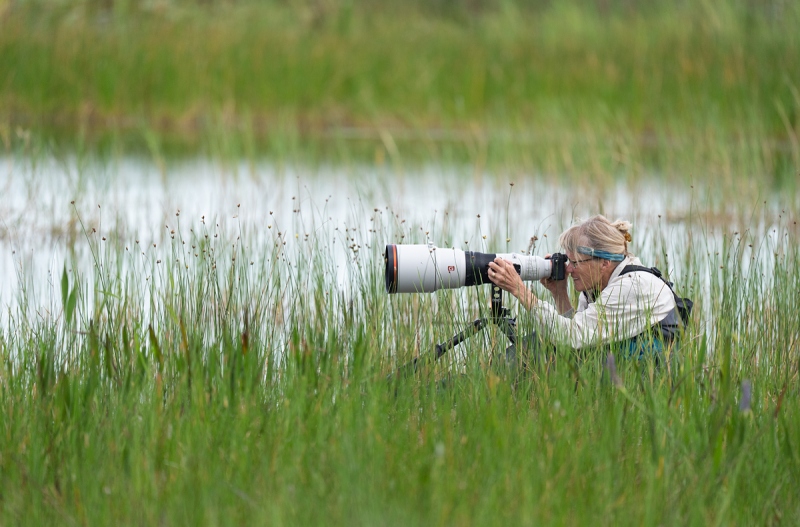
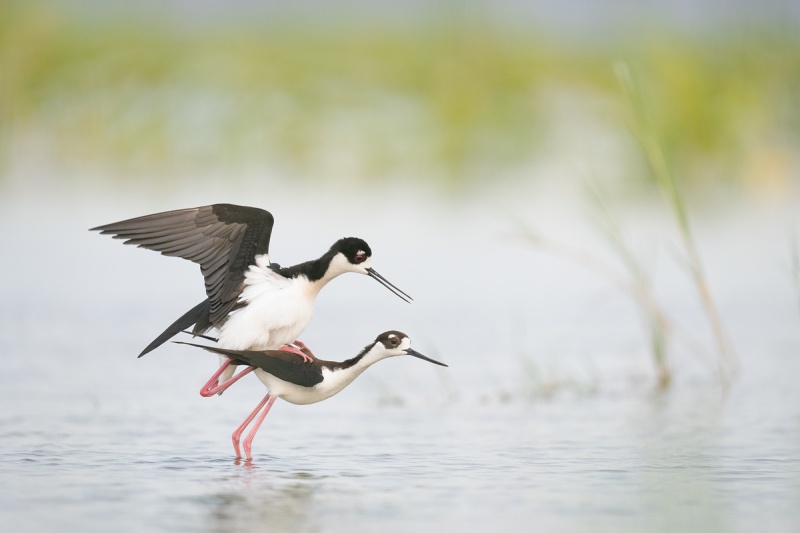
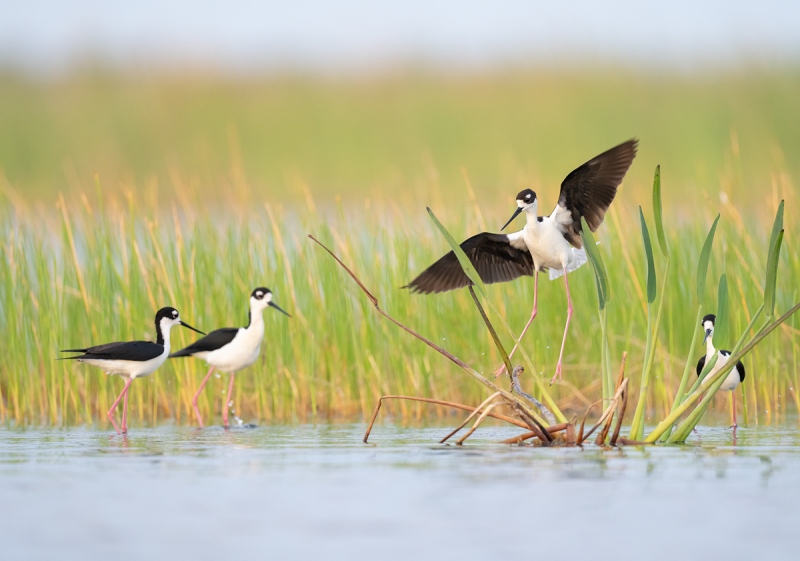
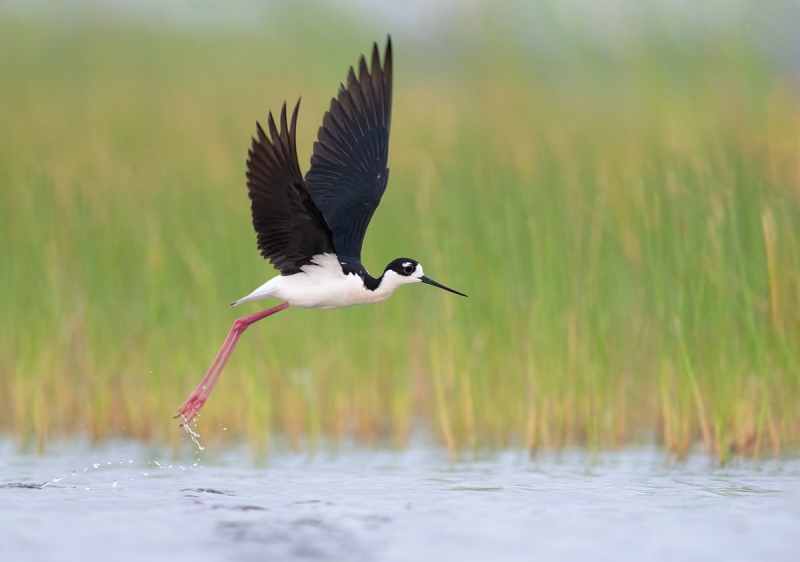
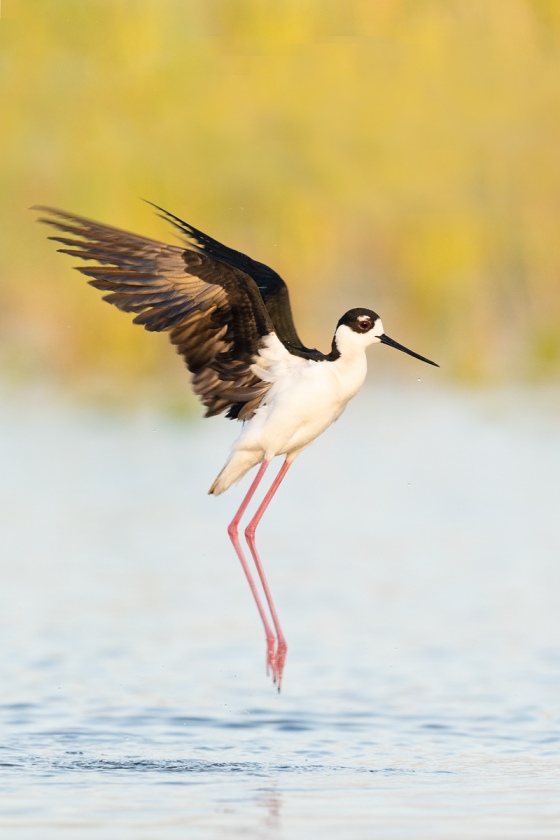
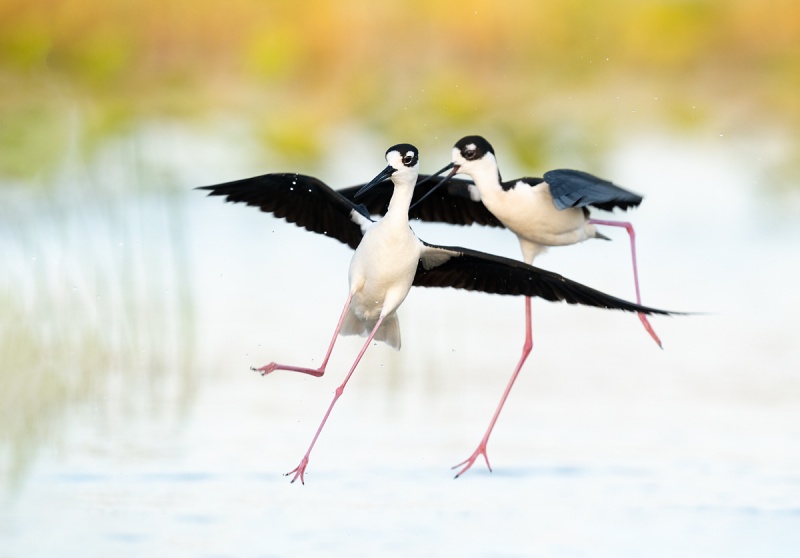













Images #2, #5 and #6 have a large number of “lighter” pixels …. in manual mode if she adjusted ISO on the rear dial based on zebras in the large bright areas she then left the darker areas (especially the black plumage on the birds) under-exposed. It might have been better to let those brighter areas “blow out” and get better exposure on the blacks.
No. 6 for me. Love the action in the photo.
Hi Artie,
My choice for favourite image is #5 I love the composition and overall bird pose caught while flapping after bathing.
Thanks, David.
Regarding your question concerning three errors with the aperture setting in images 2,5&6, it looks to me that Anita may have meant to shoot wide open at f4.
She should have been at f/4 … Why?
I assembled the exit data in a grid , earliest to latest by time. The order is #6,#5,#2 then #3&4.
The shooting time for these images covers 15 minutes, 6.53 to 7.07 am right around sunrise.
I think that you forgot to note that 5 & 6 were created on her second day in much brighter conditions.
I am surmising that Anita obtained the correct exposure “ determined with zebras via iso on the rear dial” but with less than optimal settings. Perhaps for images five and six, taken just before sunrise , Anita did not notice her aperture setting at f5.6.
For sure. If you think about it, you might be able to figure out why.
I do not think she was looking for increased depth of field because the subjects were at close range as you explained already to several people.
You are correct sir.
From image #5 at 6.54 to image #2 at 7.00 the exposure settings indicate an increase in exposure of one stop each for iso and shutter speed plus a further 2/3 of a stop via aperture.
Thus 2 2/3 stops increased exposure indicates a dramatic drop in light for image 2. Did the rising sun hide behind a dark cloud just at that moment?
No. Again, images 5 & 6 were created on day 2 in much brighter conditions 🙂
Thanks for your thoughtful comments.
Have a great day.
David.
Always (that’s my choice) and ditto. With love, a
I like #4 for the water dripping off the feet and the beautiful green; #6 for the behavior and leg poses Wonderful photos !
Maybe folks who think there is not enough DOF are really seeing a bit of movement blur in the wings and feet?
I don’t think Yves or Sue is “off base”. Maybe they are technically wrong, but they see what they see.
It’s kind of hard to judge/examine photos on the blog because they don’t expand full size. You wouldn’t critique a photo at BPN at these sizes, would you? I can see that the focus is dead on, but I had to check that by veiwing the water/surrondings below the bird. Otherwise I couldn’t really tell. Maybe that is why Yves and Sue are bringing up depth of field??
I too thought they could use a little extra “depth of field dial” (BTW, you knew exactly what Yves meant).
Hi Anthony,
Their suggestions were and are totally unrealistic. I detailed why in my response to Yves, below. BPN jpegs are 1920 wides. These are 1200 wide once you click on them. So not a great difference. And yes, seeing anything but the full-sized master file is less than ideal but we do our best. A whole lot of folks have learned a whole lot from comments made on their 1920 wide jpegs. And for years they were a lot smaller. And still folks learned.
As you well know, sharpness and depth of field have zero to do with each other.
I stand by the fact there there is no such thing as a depth of field dial. I write thousands of words a week here on the blog and strive to make them as accurate as possible. That often involves doing considerable research. I do not think that it is asking too much for folks to phrase their comments accurately.
Anita’s images are not perfect. Had anyone pointed out some of the legitimate flaws, I would have thanked them very much. The point of the post, however, was that she worked very hard to discover a new location and got some very good images. Not to mention that the first three images were made in extreme low light conditions. I have been preaching here for years that depth of field with super-telephoto lenses, especially with subjects at relatively close range, is very thin. And lots of folks on BPN often ask for “more d-o-f” in lo light, already high ISO, slow shutter speed situations. That is why for decades my mantra has been focus on the eye, get that sharp, and to neck with depth of field.
with love, artie
You are missing the point on the “depth of field dial”. We all know it doesn’t exist. If you want to stay in your group and call things what you want, go ahead.
Your pictures are very, very small on your blog. Sometimes they don’t even enlarge bigger than the post on the screen.
I have love for Anita’s images. They are great on this post. Spectacular!
I think you need work on your website presentations of your (and others) work.
Hi Anthony,
I have no idea what you mean by this:
You are missing the point on the “depth of field dial”. We all know it doesn’t exist. If you want to stay in your group and call things what you want, go ahead.
Please explain.
When I click on the horizontal images, they look pretty good. The verticals look better when I post them at 800 high but that spoils the look of the overall page. I am doing my best. If you have any suggestions for improved IQ and SH in Word Press, I am open to suggestions.
If the photos are too large, the site bogs down …
with love, artie
Great stuff here Anita. You must have had a blast! I think the last one is my favorite. The pastels in the background and the interaction of the birds (well positioned in the frame IMO) makes for a great image. Artie doesn’t specifically suggest a different aperture, but f/5.6 still does an excellent job in dissolving the background. Just lovely!
Image #1 is my favorite 😀
My faves: For artistic beauty, image 5. For behavior, image 6.
Anita: Wow!!! Loved them all, but my favorite was #3: crisp image of stilt, beautiful background and water dripping from the bird’s feet. My next favorite was #2, but I would like it more if you cropped off the single bird on the right side.
I think the error may be that the blacks are under-exposed and lack optimum detail.
No idea why she did it. Perhaps misinterpreted the zebras?
I will trust what you are seeing but on my MacBook Pro Retina display these images look very soft…..something in the web display perhaps.
I like the single, horizontal shot, Image #4. Love the dark bird stilt against the soft pastel backdrop. I like the shallow depth of field. That is why so many love the 600mm F4.
Thanks, Mo.
with love, a
I agree with Sue that all 3 photos would benefit of a greater depth of field (probably one stop more).
Maybe Anita wanted to get a higher speed around 1/2000 but mixed the speed dial with the depth of field dial?
Hi Yves,
I am confused. There are five photos, not three. In images 1, 3, and 4 the entire bird is sharp so I am baffled as to why both of you are suggesting that each needs additional depth of field. I bit more depth of field for Image #2 might be nice but for several things:
1- Anita was at only 1/500 sec. so it is amazing that she got the jumping bird sharp.
2- She was already at ISO 3200.
3- As I keep pointing out here, depth of field with telephoto lenses is razor thin. With the two birds on our left at least several inches in front of the jumping bird, those birds would not be much sharper at f/22. f/22 is five stop smaller than f/4. And with 1/500 sec. as a minimum to get the jumping bird sharp, that would have required five more stops of ISO. That would bring you to ISO 102,400. Do you wish to reconsider your suggestion?
Lastly, there is no such thing as a depth of field dial.
Similarly, with Image #5, with the birds close to point plank lens no amount of depth of field would get the second bird sharp at 600mm.
with love, artie
Typo on image #4: Zone/AF-C was active at the moment of exposure and performed perfectly by nailing the plover’s eye.
Not a plover!
Definitely not a plover! Thanks for catching my left-over cut and paste error.
with love, artie
All 5 photos look pretty good but need a more depth of focus area. The speed choice was good and the coloring is kinda good but more focus depth and area needed. Basically they are all okay!
Hi Sue,
Please see my response to Yves’ similar comment above to learn why your comment is way off base.
with love, artie